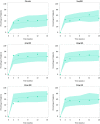Exposure-Response Analyses for Upadacitinib Efficacy and Safety in the Crohn's Disease CELEST Study and Bridging to the Extended-Release Formulation
- PMID: 31594037
- PMCID: PMC7027977
- DOI: 10.1002/cpt.1668
Exposure-Response Analyses for Upadacitinib Efficacy and Safety in the Crohn's Disease CELEST Study and Bridging to the Extended-Release Formulation
Abstract
Upadacitinib plasma concentrations, efficacy, and safety data from 216 subjects with moderate-to-severe active Crohn's disease (CD) from the 16-week induction period of the CELEST study were analyzed to characterize upadacitinib exposure-response relationships in CD. Subjects in CELEST received either placebo or upadacitinib (3, 6, 12, 24 mg b.i.d. or 24 mg q.d.). Exposure-response models were developed and utilized to simulate efficacy of induction doses of the immediate-release (IR) and extended-release (ER) formulations. Upadacitinib exposures associated with 18-24 mg b.i.d. (IR formulation) or 45-60 mg q.d. (ER formulation) are estimated to have greater efficacy during 12-week induction in patients with CD compared with lower doses. No exposure-response relations were observed with decreases in hemoglobin or lymphocytes at week 16 or with herpes zoster infections, pneumonia, or serious infections during 16 weeks of treatment in this study. These analyses informed the selection of upadacitinib induction dose for phase III studies in CD.
© 2019 AbbVie Inc. Clinical Pharmacology & Therapeutics published by Wiley Periodicals, Inc. on behalf of American Society for Clinical Pharmacology and Therapeutics.
Conflict of interest statement
Mohamed‐Eslam F. Mohamed, Ben Klünder, Ana P. Lacerda, and Ahmed A. Othman are employees and shareholders of AbbVie.
Figures





Similar articles
-
Efficacy and Safety of Upadacitinib in a Randomized Trial of Patients With Crohn's Disease.Gastroenterology. 2020 Jun;158(8):2123-2138.e8. doi: 10.1053/j.gastro.2020.01.047. Epub 2020 Feb 8. Gastroenterology. 2020. PMID: 32044319 Clinical Trial.
-
Pharmacokinetics and Exposure-Response Analyses to Support Dose Selection of Upadacitinib in Crohn's Disease.Clin Pharmacol Ther. 2024 Nov;116(5):1240-1251. doi: 10.1002/cpt.3359. Epub 2024 Jul 9. Clin Pharmacol Ther. 2024. PMID: 38982567 Clinical Trial.
-
Pharmacokinetics of Upadacitinib in Healthy Subjects and Subjects With Rheumatoid Arthritis, Crohn's Disease, Ulcerative Colitis, or Atopic Dermatitis: Population Analyses of Phase 1 and 2 Clinical Trials.J Clin Pharmacol. 2020 Apr;60(4):528-539. doi: 10.1002/jcph.1550. Epub 2019 Nov 7. J Clin Pharmacol. 2020. PMID: 31701537
-
Evaluating the pharmacokinetics of upadacitinib for the treatment of moderate-to-severe Crohn's disease.Expert Opin Drug Metab Toxicol. 2024 May;20(5):297-305. doi: 10.1080/17425255.2024.2349711. Epub 2024 May 13. Expert Opin Drug Metab Toxicol. 2024. PMID: 38712496 Review.
-
Upadacitinib in Crohn's disease.Expert Opin Pharmacother. 2024 Mar;25(4):359-370. doi: 10.1080/14656566.2024.2333964. Epub 2024 Mar 29. Expert Opin Pharmacother. 2024. PMID: 38512115 Review.
Cited by
-
Clinical Pharmacokinetics of Upadacitinib: Review of Data Relevant to the Rheumatoid Arthritis Indication.Clin Pharmacokinet. 2020 May;59(5):531-544. doi: 10.1007/s40262-019-00855-0. Clin Pharmacokinet. 2020. PMID: 31867699 Free PMC article. Review.
-
Upadacitinib in Crohn's Disease: A Comprehensive Systematic Review of Efficacy and Safety.Cureus. 2023 Dec 17;15(12):e50657. doi: 10.7759/cureus.50657. eCollection 2023 Dec. Cureus. 2023. PMID: 38229787 Free PMC article. Review.
-
Upadacitinib pharmacokinetics and exposure-response analyses of efficacy and safety in psoriatic arthritis patients - Analyses of phase III clinical trials.Clin Transl Sci. 2022 Jan;15(1):267-278. doi: 10.1111/cts.13146. Epub 2021 Oct 27. Clin Transl Sci. 2022. PMID: 34464029 Free PMC article. Clinical Trial.
-
Model-Informed Paradigm in Drug Development-An End-To-End Case Study From Upadacitinib Development.Clin Transl Sci. 2025 Aug;18(8):e70295. doi: 10.1111/cts.70295. Clin Transl Sci. 2025. PMID: 40763919 Free PMC article. Review.
-
Novel Therapies for Patients With Inflammatory Bowel Disease.Gastroenterol Hepatol (N Y). 2022 Aug;18(8):453-465. Gastroenterol Hepatol (N Y). 2022. PMID: 36397817 Free PMC article.
References
-
- Eustace, G.J. & Melmed, G.Y. Therapy for Crohn's disease: a review of recent developments. Curr. Gastroenterol. Rep. 20, 19 (2018). - PubMed
-
- Cholapranee, A. , Hazlewood, G.S. , Kaplan, G.G. , Peyrin‐Biroulet, L. & Ananthakrishnan, A.N. Systematic review with meta‐analysis: comparative efficacy of biologics for induction and maintenance of mucosal healing in Crohn's disease and ulcerative colitis controlled trials. Aliment. Pharmacol. Ther. 45, 1291–1302 (2017). - PMC - PubMed
-
- Ma, C. et al Heterogeneity in definitions of efficacy and safety endpoints for clinical trials of Crohn's disease: a systematic review for development of a core outcome set. Clin. Gastroenterol. Hepatol. 16, 1407–1419 (2018). - PubMed
-
- Danese, S. , Fiorino, G. & Peyrin‐Biroulet, L. Early intervention in Crohn's disease: towards disease modification trials. Gut 66, 2179–2187 (2017). - PubMed
-
- Bouguen, G. & Peyrin‐Biroulet, L. Surgery for adult Crohn's disease: what is the actual risk? Gut 60, 1178–1181 (2011). - PubMed
Publication types
MeSH terms
Substances
LinkOut - more resources
Full Text Sources
Other Literature Sources
Medical

